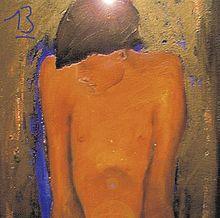| 13 | ||||
|---|---|---|---|---|
 | ||||
| Studio album by | ||||
| Released | 15 March 1999 | |||
| Recorded | June–October 1998 | |||
| Studio | ||||
| Genre | ||||
| Length | 66:50 | |||
| Label | ||||
| Producer |
| |||
| Blur chronology | ||||
| ||||
| Singles from 13 | ||||
| ||||
13 is the sixth studio album by the English alternative rock band Blur, released on 15 March 1999. Continuing the stylistic shift away from the Britpop sound of the band's early career, 13 explores experimental, psychedelic and electronic music.
Recording took place from June to October 1998 in London and Reykjavík. The album marks a departure of the band's longtime producer, Stephen Street, with his role being filled by William Orbit, who they had chosen after the release of the remix album, Bustin' + Dronin' (1998). Relationships between the band members were reported to be strained, with members frequently missing from the sessions. Lyrically, the album is significantly darker and more innovative than Blur's previous efforts, being heavily inspired by Damon Albarn's breakup with long-term girlfriend, Justine Frischmann, which followed an increasingly strained relationship. This album was the last for over a decade to feature the original line-up as Coxon left the band during the 2002 sessions of their next album Think Tank (2003), before returning for The Magic Whip (2015).
13 was released on 15 March 1999 and entered the UK Albums Chart at number one, making it Blur's fourth consecutive studio album to reach the top spot. The album was later certified Platinum. 13 also reached number one in Norway and charted within the top 20 in many other countries. The album produced three singles – "Tender", "Coffee & TV" and "No Distance Left to Run" – which charted at number 2, number 11 and number 14 respectively on the UK Singles Chart. 13 met with favourable reviews and received a nomination for the Mercury Prize, as well as for Best Album at the 2000 NME Awards.
- ^ "The Life of Blur", by Martin Power – "13 is further evidence that Blur are deadly serious about reinventing themselves as a challenging, experimental art-rock act, melding US noise with European-noir Electronica"
- ^ Cite error: The named reference
Qwas invoked but never defined (see the help page). - ^ "Britpop is dead, long live Blur". The Telegraph. 11 March 1999. Archived from the original on 2 September 2018. Retrieved 2 November 2020.
- ^ "91 Essential Alternative Rock Albums of the '90s". Treble. 20 September 2023.
- ^ "テンダー | ブラー" [Tender | Blur] (in Japanese). Oricon. Retrieved 26 November 2023.
- ^ "New Releases – For Week Starting 28 June, 1999". Music Week. 26 June 1999. p. 25.
- ^ "New Releases – For Week Starting 15 November, 1999: Singles". Music Week. 13 November 1999. p. 27.